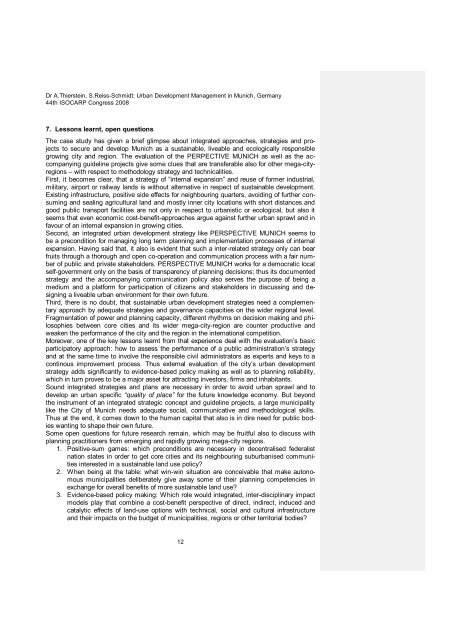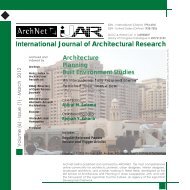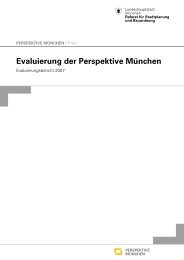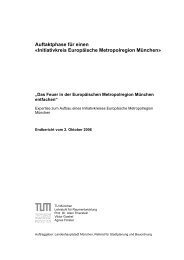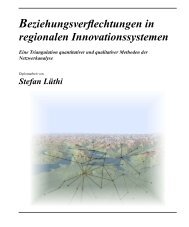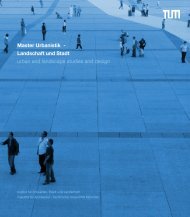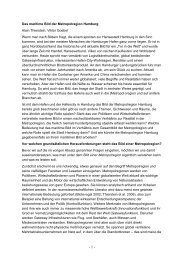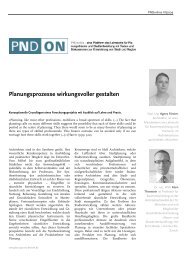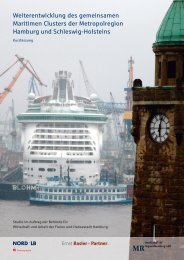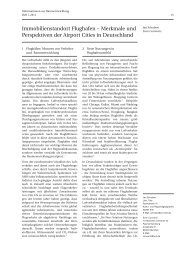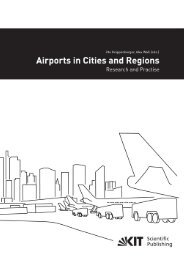Urban Development in Munich - Raumentwicklung TUM
Urban Development in Munich - Raumentwicklung TUM
Urban Development in Munich - Raumentwicklung TUM
Create successful ePaper yourself
Turn your PDF publications into a flip-book with our unique Google optimized e-Paper software.
Dr A.Thierste<strong>in</strong>, S.Reiss-Schmidt: <strong>Urban</strong> <strong>Development</strong> Management <strong>in</strong> <strong>Munich</strong>, Germany<br />
44th ISOCARP Congress 2008<br />
7. Lessons learnt, open questions<br />
The case study has given a brief glimpse about <strong>in</strong>tegrated approaches, strategies and projects<br />
to secure and develop <strong>Munich</strong> as a susta<strong>in</strong>able, liveable and ecologically responsible<br />
grow<strong>in</strong>g city and region. The evaluation of the PERPECTIVE MUNICH as well as the accompany<strong>in</strong>g<br />
guidel<strong>in</strong>e projects give some clues that are transferable also for other mega-cityregions<br />
– with respect to methodology strategy and technicalities.<br />
First, it becomes clear, that a strategy of ”<strong>in</strong>ternal expansion” and reuse of former <strong>in</strong>dustrial,<br />
military, airport or railway lands is without alternative <strong>in</strong> respect of susta<strong>in</strong>able development.<br />
Exist<strong>in</strong>g <strong>in</strong>frastructure, positive side effects for neighbour<strong>in</strong>g quarters, avoid<strong>in</strong>g of further consum<strong>in</strong>g<br />
and seal<strong>in</strong>g agricultural land and mostly <strong>in</strong>ner city locations with short distances and<br />
good public transport facilities are not only <strong>in</strong> respect to urbanistic or ecological, but also it<br />
seems that even economic cost-benefit-approaches argue aga<strong>in</strong>st further urban sprawl and <strong>in</strong><br />
favour of an <strong>in</strong>ternal expansion <strong>in</strong> grow<strong>in</strong>g cities.<br />
Second, an <strong>in</strong>tegrated urban development strategy like PERSPECTIVE MUNICH seems to<br />
be a precondition for manag<strong>in</strong>g long term plann<strong>in</strong>g and implementation processes of <strong>in</strong>ternal<br />
expansion. Hav<strong>in</strong>g said that, it also is evident that such a <strong>in</strong>ter-related strategy only can bear<br />
fruits through a thorough and open co-operation and communication process with a fair number<br />
of public and private stakeholders. PERSPECTIVE MUNICH works for a democratic local<br />
self-government only on the basis of transparency of plann<strong>in</strong>g decisions; thus its documented<br />
strategy and the accompany<strong>in</strong>g communication policy also serves the purpose of be<strong>in</strong>g a<br />
medium and a platform for participation of citizens and stakeholders <strong>in</strong> discuss<strong>in</strong>g and design<strong>in</strong>g<br />
a liveable urban environment for their own future.<br />
Third, there is no doubt, that susta<strong>in</strong>able urban development strategies need a complementary<br />
approach by adequate strategies and governance capacities on the wider regional level.<br />
Fragmentation of power and plann<strong>in</strong>g capacity, different rhythms on decision mak<strong>in</strong>g and philosophies<br />
between core cities and its wider mega-city-region are counter productive and<br />
weaken the performance of the city and the region <strong>in</strong> the <strong>in</strong>ternational competition.<br />
Moreover, one of the key lessons learnt from that experience deal with the evaluation‟s basic<br />
participatory approach: how to assess the performance of a public adm<strong>in</strong>istration‟s strategy<br />
and at the same time to <strong>in</strong>volve the responsible civil adm<strong>in</strong>istrators as experts and keys to a<br />
cont<strong>in</strong>ous improvement process. Thus external evaluation of the city‟s urban development<br />
strategy adds significantly to evidence-based policy mak<strong>in</strong>g as well as to plann<strong>in</strong>g reliability,<br />
which <strong>in</strong> turn proves to be a major asset for attract<strong>in</strong>g <strong>in</strong>vestors, firms and <strong>in</strong>habitants.<br />
Sound <strong>in</strong>tegrated strategies and plans are necessary <strong>in</strong> order to avoid urban sprawl and to<br />
develop an urban specific “quality of place” for the future knowledge economy. But beyond<br />
the <strong>in</strong>strument of an <strong>in</strong>tegrated strategic concept and guidel<strong>in</strong>e projects, a large municipality<br />
like the City of <strong>Munich</strong> needs adequate social, communicative and methodological skills.<br />
Thus at the end, it comes down to the human capital that also is <strong>in</strong> dire need for public bodies<br />
want<strong>in</strong>g to shape their own future.<br />
Some open questions for future research rema<strong>in</strong>, which may be fruitful also to discuss with<br />
plann<strong>in</strong>g practitioners from emerg<strong>in</strong>g and rapidly grow<strong>in</strong>g mega-city regions.<br />
1. Positive-sum games: which preconditions are necessary <strong>in</strong> decentralised federalist<br />
nation states <strong>in</strong> order to get core cities and its neighbour<strong>in</strong>g suburbanised communities<br />
<strong>in</strong>terested <strong>in</strong> a susta<strong>in</strong>able land use policy?<br />
2. When be<strong>in</strong>g at the table: what w<strong>in</strong>-w<strong>in</strong> situation are conceivable that make autonomous<br />
municipalities deliberately give away some of their plann<strong>in</strong>g competencies <strong>in</strong><br />
exchange for overall benefits of more susta<strong>in</strong>able land use?<br />
3. Evidence-based policy mak<strong>in</strong>g: Which role would <strong>in</strong>tegrated, <strong>in</strong>ter-discipl<strong>in</strong>ary impact<br />
models play that comb<strong>in</strong>e a cost-benefit perspective of direct, <strong>in</strong>direct, <strong>in</strong>duced and<br />
catalytic effects of land-use options with technical, social and cultural <strong>in</strong>frastructure<br />
and their impacts on the budget of municipalities, regions or other territorial bodies?<br />
12


